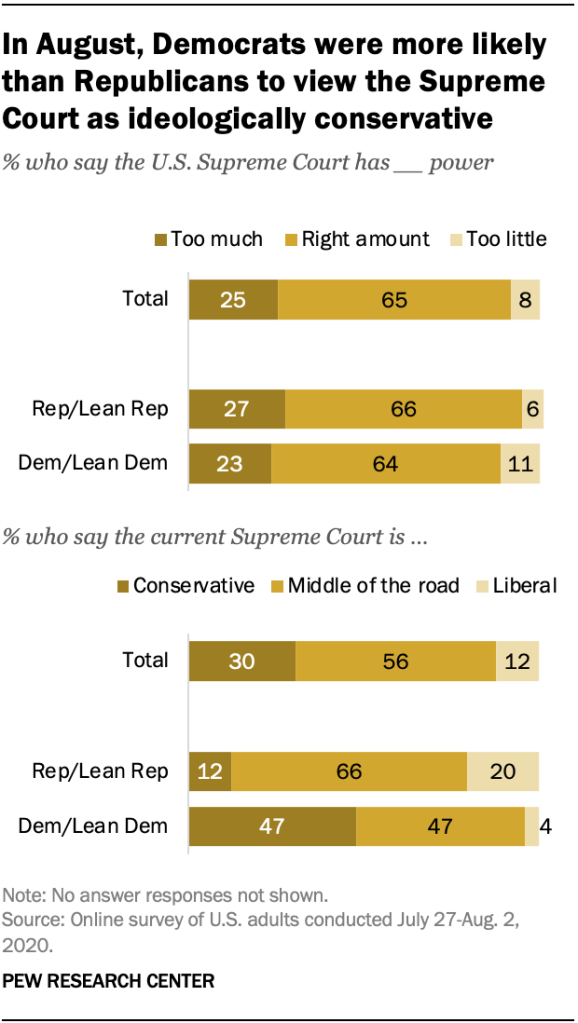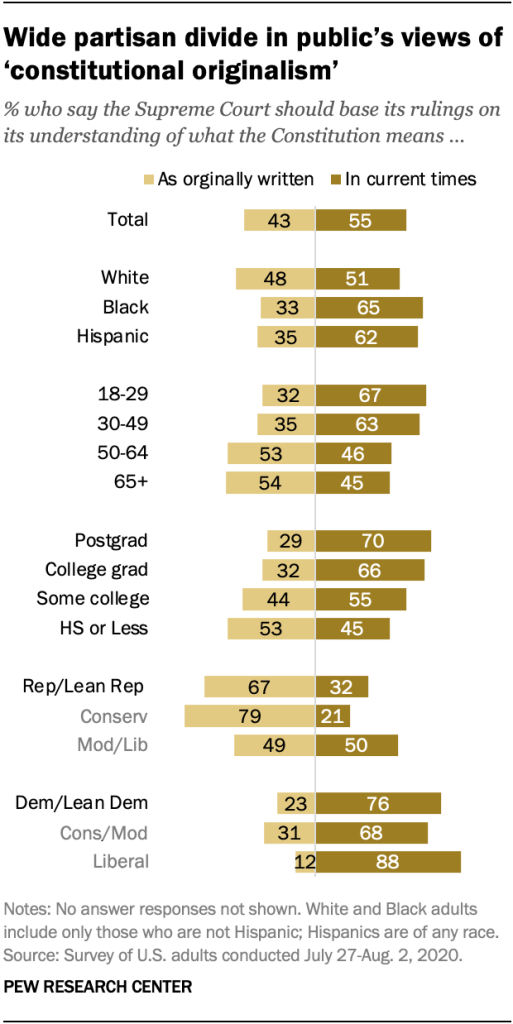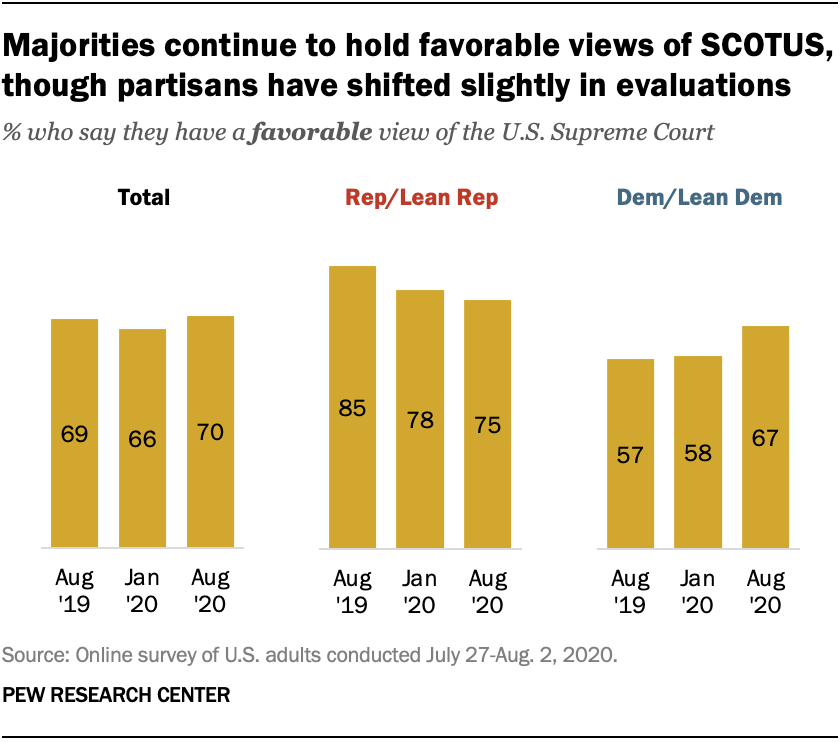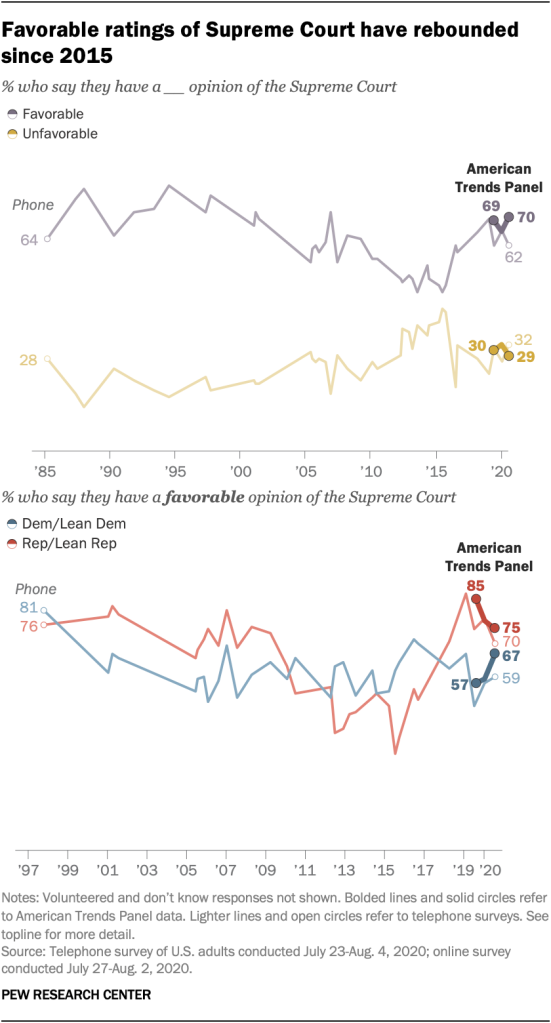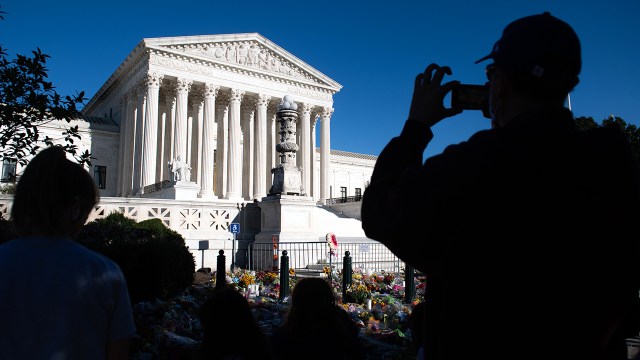
Before Justice Ruth Bader Ginsburg’s death on Sept. 18, majorities of Americans said the Supreme Court has the right amount of power and that the court is “middle of the road” ideologically.
Nearly two-thirds of Americans (65%) said the Supreme Court has the right amount of power. Similar shares of Republicans and Republican-leaning independents (66%) and Democrats and Democratic leaners (64%) said the court has the right amount of power, according to a national Pew Research Center survey conducted July 27-Aug. 2 among 11,001 adults.
A smaller majority (56%) viewed the Supreme Court as middle of the road rather than liberal or conservative. Republicans (66%) were more likely than Democrats (47%) to say the court is middle of the road. Nearly half of Democrats (47%) – including 58% of liberal Democrats – saw the court as conservative, compared with just 12% of Republicans.
Partisans’ views of the Supreme Court’s ideology have changed since 2016. The share of Republicans who view the court as middle of the road has increased while the share who say it is liberal has fallen. Over the same period, Democrats have become more likely to say the court is conservative. Since 2016, President Donald Trump has appointed two justices to the court.
The Supreme Court vacancy left by the death of Justice Ruth Bader Ginsburg has put a focus on how her replacement will affect the ideological balance of the court. This post explores how Americans have viewed that balance up till now.
In recent years, Pew Research Center has transitioned from probability-based telephone surveys to the American Trends Panel (ATP), a probability-based online panel. The transition from phone surveys conducted with an interviewer to online self-administered surveys brings with it the possibility of mode differences – differences arising from the method of interviewing.
This post includes opinion measures about favorability ratings toward the Supreme Court, as well as perceptions of the court’s ideology over time.
These questions, which have long-standing telephone trends, were included on a survey conducted July 27-Aug. 2, 2020, on the American Trends Panel among 11,001 adults, on which this report is largely based, and a contemporaneous telephone survey conducted July 23-Aug. 4, 2020, among 1,750 adults.
The ATP is an online survey panel that is recruited through national, random sampling of residential addresses. This way nearly all U.S. adults have a chance of selection. The survey is weighted to be representative of the U.S. adult population by gender, race, ethnicity, partisan affiliation, education and other categories. Read more about the ATP’s methodology.
Here are the questions used for this report, along with responses, and its methodology.
While opinions of the court’s ideological leanings were divided along partisan lines, comparable shares of registered voters who said they supported Joe Biden (66%) and Donald Trump (61%) in the presidential election viewed Supreme Court appointments as “very important” to their voting decisions.
Republicans and Democrats also had sizable differences in opinions of how the Supreme Court should base its rulings. Among the public overall, a majority of Americans said the court should base its rulings on its understanding of what the Constitution means in current times (55%); fewer said it should base its rulings on what the Constitution “meant as originally written” (43%).
As had been the case for more than a decade, Democrats were considerably more likely than Republicans to say the Supreme Court should base its rulings on what the Constitution means in current times (76% vs. 32%, respectively).
There were sizable differences within each partisan coalition on this question: 50% of moderate or liberal Republicans said the high court should base rulings on the Constitution in context of current times, while fewer than half as many conservative Republicans said the same (21%). Among Democrats, liberals (88%) were more likely than conservatives and moderates to say the court should base rulings more on current context.
White adults were more likely than Black and Hispanic adults to say the Supreme Court should base its rulings on its understanding of what the Constitution means as originally written; about half of White adults said this (48%) compared with smaller shares of Black (33%) and Hispanic (35%) adults.
Younger adults – as well as those with higher levels of education – were more likely to say the court should base its rulings on what the Constitution means in current times. About two-thirds of those younger than 50 said this, as well as a similar share of those with a college degree or more.
The Supreme Court was viewed favorably by a 70% majority of Americans in the August survey. The public’s views of the court have been positive in recent years – recovering from a low point in 2015 that followed controversial rulings on the Affordable Care Act and same-sex marriage.
Since August 2019, the share of Republicans with a favorable impression of the court has declined 10 percentage points (from 85% to 75%), while Democrats’ views have become more positive, increasing from 57% to 67%.
Long-term trends in opinions about the U.S. Supreme Court
In recent years, Pew Research Center has transitioned from probability-based telephone surveys to the American Trends Panel (ATP), a probability-based online panel. The transition from phone surveys conducted with an interviewer to online self-administered surveys brings with it the possibility of mode differences – differences arising from the method of interviewing.
This post includes opinion measures about favorability ratings toward the Supreme Court, as well as perceptions of the court’s ideology over time.
These questions, which have long-standing telephone trends, were included on a survey conducted July 27-Aug. 2 on the ATP among 11,001 adults, on which this report is largely based, and a contemporaneous telephone survey, conducted July 23-Aug. 4 among 1,750 adults.
In views of the Supreme Court among the public overall, majorities continued to hold more favorable than unfavorable views. When asked in an online survey using the Center’s American Trends Panel, 70% of Americans expressed a favorable opinion of the Supreme Court, while 29% had an unfavorable view. In a contemporaneous phone survey, 62% had a favorable opinion of the court, while 32% viewed it unfavorably. The share offering no opinion was higher on the phone survey (6%) than on the online survey (2%). In both survey modes, Republicans were more likely than Democrats to express favorable opinions of the court.
The long-term trend on favorability of the Supreme Court (from phone surveys) shows that positive views of the court recovered since slipping to 48% in July 2015. Most of that change has come among Republicans. Just 33% of Republicans had a favorable view of the court in July 2015; that share more than doubled to 70% in the most recent phone survey.
In views of the Supreme Court’s ideology, the overall pattern of opinion was similar, though there were some differences in the point estimates between the online and telephone surveys: Far fewer adults today said the court was liberal than said this for much of the last decade. This includes declining shares of Republicans and Democrats who expressed this view.
As has been true for the last several years, more adults said the Supreme Court is “middle of the road” than conservative or liberal. Still, in both the phone and online surveys, larger shares said the Supreme Court was conservative than liberal.
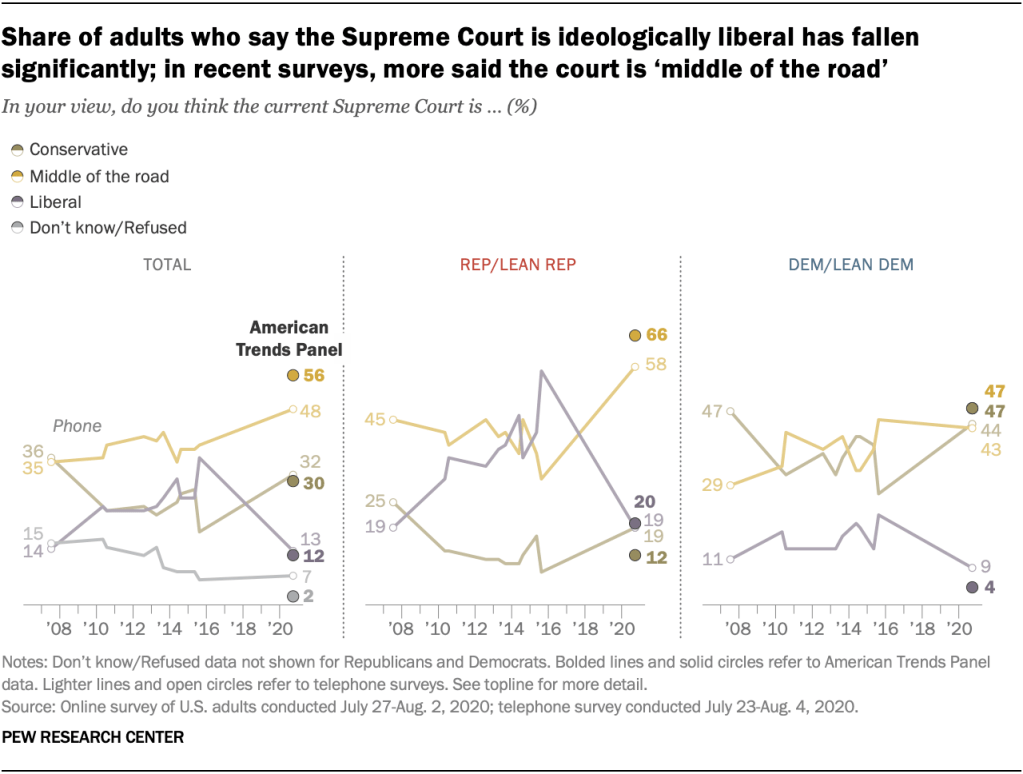
Note: Here are the questions used for this report, along with responses, and its methodology.
